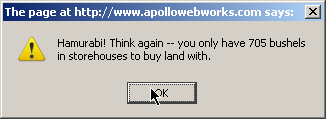Retro Replay Review
Gameplay
Hamurabi’s gameplay is deceptively simple yet remarkably deep. At its core, you’re managing a Sumerian city-state, making decisions on land purchases, grain distribution, and population welfare. Each turn—representing one year in the reign of Hammurabi—requires you to balance the needs of your people against limited resources, all through a minimalist number-entry interface. By punching in figures for acres to buy or sell, bushels of grain to feed your citizens, and fields to sow, you quickly realize that every choice carries weight.
(HEY YOU!! We hope you enjoy! We try not to run ads. So basically, this is a very expensive hobby running this site. Please consider joining us for updates, forums, and more. Network w/ us to make some cash or friends while retro gaming, and you can win some free retro games for posting. Okay, carry on 👍)
Although the interaction is largely text-based, the game’s elegant algorithms breathe life into each decision. Natural events like famines, plagues, and rat infestations occur randomly yet plausibly, forcing you to adapt strategies on the fly. Starsvexers of micro-management will appreciate how each grain allocation or land deal can ripple through subsequent years, affecting immigration, harvest yields, and overall population morale.
The challenge ramps up as you progress: poor decisions can lead to mass starvation or depopulation, while conservative play stifles growth and prosperity. This constant tension keeps every turn engaging. Despite only ten turns in the popular iPhone port, each virtual year feels substantial, demanding foresight and a touch of luck. Veteran players quickly learn to analyze past harvest data and immigration trends, turning raw numbers into a blueprint for a thriving kingdom.
Graphics
Visually, Hamurabi keeps things refreshingly retro. There are no lush landscapes, detailed character sprites, or dynamic 3D models—just crisp text and simple prompts. On modern devices, the interface borders on minimalist, but this austerity is purposeful. The lack of flashy visuals directs your focus entirely on strategy, reminiscent of early TeleType terminals and mainframe screens.
In the iPhone adaptation, the text is presented cleanly on a neutral background, with intuitive buttons for Yes/No queries. Grain icons and land-cost indicators are rendered as flat, monochrome symbols, evoking vintage computing. While some players might find the presentation stark, others will relish its old-school charm and the way it harkens back to the dawn of computer gaming.
Ultimately, Hamurabi’s graphics are less about aesthetic appeal and more about functional clarity. There’s no animation of fields growing or citizens celebrating harvest festivals; instead, the game relies on narrative feedback to illustrate prosperity or disaster. This stripped-down approach may feel austere, but it underscores the title’s heritage as a pioneering management sim and keeps your attention squarely on resource optimization.
Story
Hamurabi offers a sparse narrative framework centered on the historical figure Hammurabi, famed for his law code in ancient Sumeria. While the game doesn’t delve into court intrigue or character-driven subplots, it does place you in the sandals of a ruler whose primary duty is the welfare of his subjects. Each turn’s text summary—detailing harvest yields, population changes, and calamities—serves as a minimalist chronicle of your reign.
The absence of a conventional storyline actually enhances the sense of emergent narrative. You become the storyteller through the outcomes you engineer: a famine one year might spark a desperate struggle, followed by jubilation if you weather the crisis successfully. These organic highs and lows form your own legend, culminating in the computer’s grand proclamation: “A FANTASTIC PERFORMANCE!!! CHARLEMAGNE, DISRAELI, AND JEFFERSON COMBINED COULD NOT HAVE DONE BETTER!”
Despite its brevity, the game’s narrative impact is surprisingly enduring. You remember the year when a plague decimated half your citizens, or the season in which record grain prices allowed you to expand your territory. In that sense, the storyline is not handed to you on a silver platter but is written in the numerical footprints of your decisions, forging a unique saga each playthrough.
Overall Experience
Playing Hamurabi today feels like stepping into a time capsule of gaming history. Its stripped-back mechanics remind you how a handful of numbers and simple text prompts laid the foundation for modern strategy and simulation titles. For players intrigued by economic puzzles and leadership challenges, the game delivers a pure, undiluted experience.
On the flip side, those accustomed to rich visuals and complex control schemes may find the pace glacial and the interface austere. There are no side quests, no character customization, and no real-time action—just ten hard-fought turns to prove your mettle as Hammurabi the Wise. Yet for many, this very simplicity is the game’s greatest strength.
In closing, Hamurabi is a compelling relic that showcases the genesis of managerial simulations. Its blend of resource juggling, unpredictable events, and numerical transparency provides an intellectually stimulating challenge. Whether you’re a history buff, a strategy enthusiast, or simply curious about gaming’s origins, Hamurabi offers a rewarding, thought-provoking journey into the dawn of digital rulers.
 Retro Replay Retro Replay gaming reviews, news, emulation, geek stuff and more!
Retro Replay Retro Replay gaming reviews, news, emulation, geek stuff and more!









Reviews
There are no reviews yet.